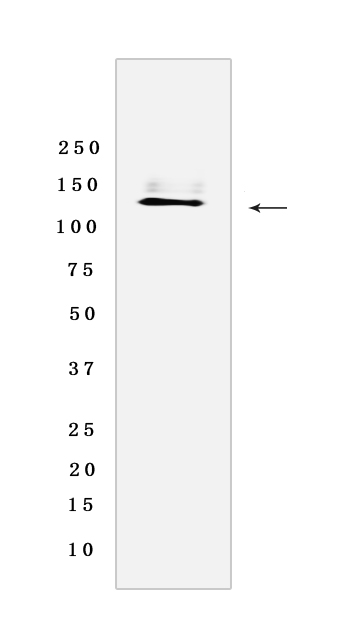FNIP1 Rabbit mAb [N558]Cat NO.: A72379
Western blot analysis of extracts from Recombinant protein .using FNIP1 Rabbit mAb [N558] at dilution of 1:1000 incubated at 4℃ over night
Product information
Protein names :FNIP1,KIAA1961,FNIP1_HUMAN,Folliculin-interacting protein 1
UniProtID :Q8TF40
MASS(da) :130,555
MW(kDa) :131 kDa
Form :Liquid
Purification :Protein A purification
Host :Rabbit
Isotype :IgG
sensitivity :Endogenous
Reactivity :Human
- ApplicationDilution
- 免疫印迹(WB)1:1000-2000
- 免疫组化(IHC)1:100,
- The optimal dilutions should be determined by the end user
Specificity :Antibody is produced by immunizing animals with a synthetic peptide of Human FNIP1.
Storage :Antibody store in 10 mM PBS, 0.5mg/ml BSA, 50% glycerol. Shipped at 4°C. Store at-20°C or -80°C. Products are valid for one natural year of receipt.Avoid repeated freeze / thaw cycles.
WB Positive detected :Recombinant protein
Function : Binding partner of the GTPase-activating protein FLCN: involved in the cellular response to amino acid availability by regulating the mTORC1 signaling cascade controlling the MiT/TFE factors TFEB and TFE3 (PubMed:17028174, PubMed:18663353, PubMed:24081491). In low-amino acid conditions, component of the lysosomal folliculin complex (LFC) on the membrane of lysosomes, which inhibits the GTPase-activating activity of FLCN, thereby inactivating mTORC1 and promoting nuclear translocation of TFEB and TFE3 (By similarity). Upon amino acid restimulation, disassembly of the LFC complex liberates the GTPase-activating activity of FLCN, leading to activation of mTORC1 and subsequent cytoplasmic retention of TFEB and TFE3 (By similarity). Required to promote FLCN recruitment to lysosomes and interaction with Rag GTPases (PubMed:24081491). Together with FLCN, regulates autophagy: following phosphorylation by ULK1, interacts with GABARAP and promotes autophagy (PubMed:25126726). In addition to its role in mTORC1 signaling, also acts as a co-chaperone of HSP90AA1/Hsp90: following gradual phosphorylation by CK2, inhibits the ATPase activity of HSP90AA1/Hsp90, leading to activate both kinase and non-kinase client proteins of HSP90AA1/Hsp90 (PubMed:27353360, PubMed:30699359). Acts as a scaffold to load client protein FLCN onto HSP90AA1/Hsp90 (PubMed:27353360). Competes with the activating co-chaperone AHSA1 for binding to HSP90AA1, thereby providing a reciprocal regulatory mechanism for chaperoning of client proteins (PubMed:27353360). Also acts as a core component of the reductive stress response by inhibiting activation of mitochondria in normal conditions: in response to reductive stress, the conserved Cys degron is reduced, leading to recognition and polyubiquitylation by the CRL2(FEM1B) complex, followed by proteasomal (By similarity). Required for B-cell development (By similarity)..
Tissue specificity :Strong expression is found in the heart, liver placenta, muscle, nasal mucosa, salivary gland and uvula and moderate expression in kidney and lung. Higher levels detected in clear cell renal cell carcinoma (RCC) and chromophobe RCC than in normal kidney tissue..
Subcellular locationi :Lysosome membrane. Cytoplasm, cytosol.
IMPORTANT: For western blots, incubate membrane with diluted primary antibody in 1% w/v BSA, 1X TBST at 4°C overnight.


